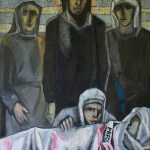
I am unable to address Abed Abdi’s catalogue from the purely technical and professional composition aspect. The historical profundity of Abdi’s experience places him in the category of artist-phenomenon. As a consequence of his intellectual and spiritual accumulation of experiences and the interaction between them, it would be more appropriate for me to go beyond the conventional tools of critique. In the special case of Abdi, an artist who has been creating for fifty years on a journey of artistic work, struggle and artistic commitment in the face of a life filled with suffering, hardship and challenges, I shall attempt to reconstruct the harmony between his ideology and practice, the congruence between art and struggle in his overall conceptual fabric.
Since he started out, Abdi’s brush has attracted my attention. He offered a unique approach.
When I asked him for a print for the cover of my second collection of poems, Poems of the Roads, in 1964, he assented with loving enthusiasm. He recognized the harmony in our work: an array that is immersed in the national and human pain of the Palestinian people, and a poem inundated with that pain.

From the very beginning there was a close relationship and interaction between the works of Abed Abdi, Ismail Shammout and Gershon Knispel, and those of the wonderful muralist Siqueiros. It was only natural since they were all knights in the creative company that maintains ideological commitment and is not satisfied with esthetic values, but goes beyond it to offer both the beautiful and the beneficial. Perhaps this is an opportunity to mention that there were some who tried to distort the meaning and essence of commitment in art by claiming that it constituted dependence upon a political party, a government, an institution or politics. Those who thus contend are those who come from a lame, dubious and dependent political position. In artistic creation, commitment is a voluntary position and is made out of choice deriving from a profound perception of Man’s unity and existence, and the dialectics between reality, life and development.
Hence, the committed artist is of necessity more progressive, his spiritual world is more beautiful, and his objectives loftier than those of the uncommitted, artist, the collaborator, opportunist and hypocrite.

Abdi’s extensive use of black and white in his work from the 1960s captured my attention. Because of my admiration for his work and our friendship, I encouraged him to enter the world of colors. It was as if we shared common ideas, and it was not long before his studio was covered with all the colors of the rainbow. This was not a calculated quantum leap but rather a product of gradual and scholarly work on colors in accordance with the findings of his experience and the demands of the artistic work.
The publishing of Abdi’s new, comprehensive catalogue gives me great joy. Until then, I shall continue to enjoy his work hung on the walls of my home, for Abed Abdi is family and it is only natural that his works be part of my home.
by Samih Al Qasim



















